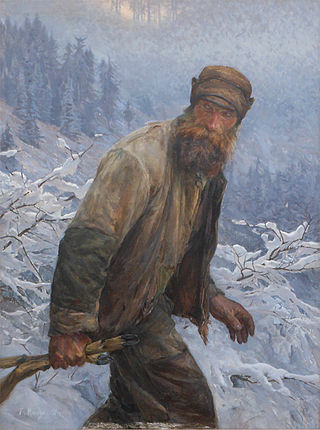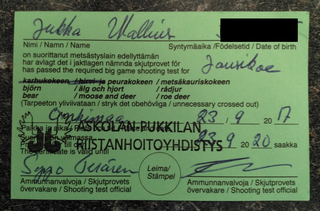
Hunting is the human practice of seeking, pursuing, capturing, and killing wildlife or feral animals. The most common reasons for humans to hunt are to obtain the animal's body for meat and useful animal products, for recreation/taxidermy, although it may also be done for resourceful reasons such as removing predators dangerous to humans or domestic animals, to eliminate pests and nuisance animals that damage crops/livestock/poultry or spread diseases, for trade/tourism, or for ecological conservation against overpopulation and invasive species.

Poaching is the illegal hunting or capturing of wild animals, usually associated with land use rights. Poaching was once performed by impoverished peasants for subsistence purposes and to supplement meager diets. It was set against the hunting privileges of nobility and territorial rulers.
The Migratory Bird Treaty Act of 1918 (MBTA), codified at 16 U.S.C. §§ 703–712, is a United States federal law, first enacted in 1918 to implement the convention for the protection of migratory birds between the United States and Canada. The statute makes it unlawful without a waiver to pursue, hunt, take, capture, kill, or sell nearly 1,100 species of birds listed therein as migratory birds. The statute does not discriminate between live or dead birds and also grants full protection to any bird parts, including feathers, eggs, and nests. A March 2020 update of the list decreased the number of species to 1,093.

Shot is a collective term for small spheres or pellets, often made of lead. These have been projected from slings since ancient times and were the original projectiles for shotguns and are still fired primarily from shotguns and grenade launchers, while they are less commonly used in riot guns. Shot shells are also available in many handgun calibers in a configuration known as "birdshot", "rat shot", or "snake shot".

Wildlife management is the management process influencing interactions among and between wildlife, its habitats and people to achieve predefined impacts. Wildlife management can include wildlife conservation, population control, gamekeeping, wildlife contraceptive and pest control.
Legislation on hunting with dogs is in place in many countries around the world. Legislation may regulate, or in some cases prohibit the use of dogs to hunt or flush wild animal species.

Waterfowl hunting is the practice of hunting aquatic birds such as ducks, geese and other waterfowls or shorebirds for sport and meat. Waterfowl are hunted in crop fields where they feed, or in areas with bodies of water such as rivers, lakes, ponds, wetlands, sloughs, or coasts. There are around 3 million waterfowl hunters in the United States alone.

The National Wildlife Refuge System in the United States has a long and distinguished history.
In the United Kingdom, the term hunting generally refers to hunting with hounds, e.g. normally fox hunting, stag (deer) hunting, beagling, or minkhunting, whereas shooting is the shooting of game birds. What is called deer hunting elsewhere is deer stalking. According to the British Association for Shooting and Conservation (BASC) over a million people a year participate in shooting, including stalking, shooting, hunting, clay shooting and target shooting. Firearm ownership is regulated by licensing.
The Lacey Act of 1900 is a conservation law in the United States that prohibits trade in wildlife, fish, and plants that have been illegally taken, possessed, transported, or sold.

A hunting license or hunting permit is a regulatory or legal mechanism to control hunting, both commercial and recreational. A license specifically made for recreational hunting is sometimes called a game license.
A hunting season is the designated time in which certain game animals can be killed in certain designated areas. In the United States, each state determines and sets its own specific dates to hunt the certain game animal, such as California, in which they designate certain zones, in which each have their own separate dates in order to legally hunt.
Game preservation is maintaining a stock of game to be hunted legally. It includes:
The Endangered Species Conservation Act of 1969 was an expansion of the Endangered Species Preservation Act of 1966 which authorized the United States Secretary of the Interior to develop a comprehensive list of species or subspecies of animals threatened with worldwide extinction. It also prohibited the importation from any foreign country any animal-whole or in part, any product, or any egg belonging to a species on that list. Limited exceptions for scientific, educational, zoological, or propagational purposes and for certain cases of commercial "economic hardship" were allowed under strict permitting procedures.
Sequoyah National Wildlife Refuge was established in 1970 to provide habitat for waterfowl and other migratory birds and to provide food and cover for resident wildlife. It contains 20,800 acres (8,400 ha) on the western edge of Robert S. Kerr Reservoir in three Oklahoma Counties: Muskogee, Haskell and Sequoyah. The refuge was named in honor of Sequoyah, a Cherokee who developed an alphabet for the Cherokee language.

The United States Fish and Wildlife Service Office of Law Enforcement contributes to Service efforts to manage ecosystems, save endangered species, conserve migratory birds, preserve wildlife habitat, restore fisheries, combat invasive species, and promote international wildlife conservation. It is an office of the United States Fish and Wildlife Service (FWS).

The Rockefeller Wildlife Refuge is a large area of marshland in Cameron Parish and Vermilion Parish, Louisiana, United States. It was donated to the state with certain provisions as to its management as a wildlife sanctuary. It is a biodiverse habitat and is visited annually by many migratory birds. Much research is undertaken into marshland management and alligator ranching, and the income from the sale of alligators contributes to conservation of the marshland.
Wildlife law in England and Wales is the law relating to the protection of wildlife in England and Wales. Much of existing UK law dates from pre-Victorian times. Wildlife was viewed as a resource to be used; phrases such as "game" or "sporting rights" appear. Public opinion is now much more in favour of protection of birds and mammals rather than the landowners’ interests.
In hunting, take or taking is a term used in the United States to refer to any action that adversely affects a species, particularly killing individuals of that species, as outlined by the United States Endangered Species Act of 1973. Although "taking" most commonly refers to the act of killing animals in a hunting context, its definition can also extend to include harassing, harming, pursuing, hunting, shooting, wounding, trapping, capturing, and collecting any plant or animal. The definition of take can also further extend to comprise the indirect harming of a species via modification of its habitat.

Hunting is a significant subsistence and recreational activity in the United States. Regulation of hunting began in the 19th century. Some modern hunters see themselves as conservationists. American hunting tradition values fair chase, which values the balance between the hunter and the animals. A 2006 poll showed that 78% of Americans support hunting. 6% of Americans have hunted. Hunting is most popular in the Midwest.










